Leggings are a comfortable and versatile piece of clothing that many people love to wear. However, sometimes leggings can be too long, which can be annoying and make them look less flattering.
Hemming your leggings is an easy way to fix this problem and make them fit you perfectly. In this guide, we will show you how to hem leggings using 3 different methods so you can choose the one that works best for you.
Whether you are a beginner or an experienced sewer, you will find this guide helpful and easy to follow. So, let’s get started!
Table of Contents
ToggleKey Takeaways
- There are 3 main methods: using a coverstitch machine, regular sewing machine, or hand sewing. Choose based on your skills and tools.
- Prepare the leggings by prewashing if needed, pressing the edge, and leaving enough seam allowance when cutting to length.
- For machine sewing, use the right stitch type and settings for a stretchy, durable hem. A walking foot can prevent stretching.
- Hand sewing allows a personalized finish on delicate fabrics when you don’t have a machine. Use a slipstitch for an invisible hem.
- To avoid uneven or wavy hems, measure carefully, don’t stretch the fabric while sewing, and consider using a hem finish that encases raw edges.
How To Hem Leggings? 3 Methods!
Material Required
- Leggings that need to be hemmed
- Fabric scissors or rotary cutter
- Measuring tape or ruler
- Pins or fabric clips, including sewing pins to hold the fabric in place before sewing
- Iron and ironing board
- Sewing machine (optional)
- Coverstitch machine (optional)
- Thread (matching the color of the leggings)
- Hand sewing needle (if hand hemming)
- Fabric marker or chalk
- Seam ripper (for removing existing hems, if necessary)
- Serger or zigzag scissors (for finishing raw edges, if desired)
- Fabric glue or clear nail polish (to prevent fraying, if needed)
- Walking foot or dual feed foot (for sewing machine hemming, if available)
- Hem tape or bias tape (for encasing raw edges, if desired)
Preparing Your Leggings for Hemming
Before you start hemming your leggings, it is important to prepare them properly. This will ensure that your leggings look great and last a long time. If your leggings are made of cotton or rayon, it is crucial to prewash them before hemming.
These fabrics tend to shrink after washing, so prewashing allows for any shrinkage to occur before you alter the length. This way, your leggings will still fit perfectly even after multiple washes.
Remember to leave a seam allowance of about half an inch when measuring and cutting your leggings to the desired length. This seam allowance is crucial for a smooth hemming process, allowing for adjustments and ensuring the hem holds up well over time.
When you are ready to hem, use a dry iron to press the edge of the leggings. Set the iron to the appropriate temperature for the fabric. As you iron, release a small puff of steam on the edge of the leggings.
This will relax the fibers and make it easier to create a smooth, even hem. If your fabric is prone to fraying, you may want to use a serger or zigzag stitch to finish the raw edge before hemming. This will prevent the fabric from unraveling and extend the life of your leggings.
By following these simple tips, you’ll be ready to hem your leggings with confidence, knowing that they will look great wash after wash.
Method 1: Hemming Leggings Using a Coverstitch Machine
A coverstitch machine is a great tool for hemming leggings. It creates a professional-looking, stretchy hem that is similar to what you see on store-bought leggings. Here’s a step-by-step guide on how to hem leggings using a coverstitch machine:
Step 1: Prepare the Leggings
Fold the hem allowance to the wrong side of the leggings and press it in Place. The hem allowance is usually about 1 inch, but check your pattern or measure the desired length. If the fabric is slippery or hard to press, you can use hem tape or pins to hold the hem in Place.
Step 2: Set up the Coverstitch Machine
Thread the machine with the appropriate threads for your fabric. Most coverstitch machines use 3-5 threads. Adjust the stitch length and tension according to your fabric type and thickness.
Refer to your machine’s manual for recommended settings. Do a test stitch on a scrap piece of fabric to ensure the settings are correct.
Step 3: Position the Leggings Under the Presser Foot
Place the leggings under the presser foot with the folded edge aligned with the right seam guide. The hem allowance should be facing up towards you. Make sure the fabric is not stretched or pulled as it goes under the presser foot.
Step 4: Begin Coverstitching
Lower the presser foot and slowly begin stitching, guiding the fabric gently as it moves under the foot. Stitch at a slow and consistent speed, keeping the folded edge aligned with the seam guide. When you reach the end, stitch off the edge of the fabric and manually turn the handwheel to release the threads.
Step 5: Secure and Finish the Threads
Use a hand-sewing needle to pull the looper threads to the back side of the hem. Tie the threads together tightly and trim the excess. Give the hem a final press to set the stitches and create a clean finish.

Advantages and Disadvantages of Using a Coverstitch Machine
| Advantages | Disadvantages |
|---|---|
| Produces a professional-looking finish that resembles store-bought leggings | Requires a specialized machine that can be expensive to purchase |
| Creates a stretchy, durable hem that moves with the fabric | May require some practice and experience to achieve the best results |
| Allows for a quick and efficient hemming process, especially for multiple pairs of leggings | The machine may be difficult to thread and set up initially |
| Provides a consistent and even hem throughout the leggings | May not be suitable for very delicate or lightweight fabrics |
| Offers a variety of stitch options and settings to customize the hem appearance | The machine can be bulky and take up significant space in your sewing area |
Method 2: Hemming Leggings Using a Sewing Machine
If you don’t have a coverstitch machine, you can still achieve professional-looking hems on your leggings with the right sewing machines.
The key to success lies in selecting sewing machines that allow for adjustable stitch options and settings, ensuring the hem is durable and stretchy enough not to break when stretched out.
This method is not only easy to do but also works well for most types of leggings, making sewing machines an indispensable tool for this DIY task.
Here’s a step-by-step guide on how to hem leggings using a sewing machine:
Step 1: Put your Leggings on Inside Out
Turn your leggings inside out and put them on. This will help you see where you want the new hem to be. Stand in front of a mirror and use a fabric marker or pin to mark the new hemline. Make sure the line is even all the way around both legs.
Step 2: Take off the Leggings and Cut off the Excess Fabric
Take off the leggings and lay them flat on a table. Use a ruler or measuring tape to measure up from the bottom of the leggings to the mark you made. Add 1 inch for the hem allowance. Cut off the excess fabric using fabric scissors.
Step 3: Fold up the Hem and Pin it in Place
Fold up the raw edge of the fabric by 1/2 inch and press it with an iron. Then, fold it up again by another 1/2 inch and pin it in Place. Make sure the hem is even all the way around the leg.
Step 4: Sew the Hem Using a Zigzag Stitch
Set your sewing machine to a zigzag stitch with a medium width and length. This will allow the hem to stretch with the fabric. Sew around the pinned hem, removing the pins as you go. Backstitch at the beginning and end to secure the stitches.
Step 5: Trim the Threads and Press the Hem
Trim any loose threads and press the hem with an iron to flatten it out. Turn the leggings right side out and try them on to make sure the hem is even and the length is perfect.
By following these simple steps, you can hem your leggings using a regular sewing machine.
This method is great for beginners and those who don’t have access to a coverstitch machine. Plus, it allows you to customize the length of your leggings to your exact preferences.
Advantages and Disadvantages of Using a Sewing Machine
The perks and limitations of using a sewing machine include:
| Advantages | Disadvantages |
|---|---|
| Easy to use | May not produce a professional finish |
| Versatile for different fabrics | Requires some skill and experience |
| Cost-effective | Can be time-consuming |
Method 3: Hemming Leggings By Hand
Sometimes, you may prefer to hem your leggings by hand instead of using a machine, especially when creating a folded hem. Hand hemming is a great option when working with delicate fabrics or wanting a more personalized finish.
It’s also a good choice if you don’t have access to a sewing machine. Here’s a step-by-step guide on how to hem leggings by hand:
Step 1: Mark the Desired Length
Put on your leggings inside out and stand in front of a mirror. Use a fabric marker or pin to mark where you want the new hem to be. Make sure the mark is even all the way around both legs.
Step 2: Cut off the Excess Fabric
Take off the leggings and lay them flat on a table. Measure up from the bottom of the leggings to the mark you made, adding 1 inch for the hem allowance. Cut off the excess fabric using fabric scissors.
Step 3: Fold and Pin the Hem
Fold the raw edge of the fabric up by 1/2 inch and press it with an iron. Then, fold it up again by another 1/2 inch and pin it in Place. Make sure the hem is even all around the leg.
Step 4: Thread your Needle and Knot the End
Choose a thread that matches your leggings and thread it through a hand-sewing needle. Tie a knot at the end of the thread to secure it.
Step 5: Sew the Hem Using a Slipstitch
Start sewing the hem using a slip stitch, which is a nearly invisible stitch that’s perfect for hemming. To do a slip stitch, insert the needle into the fold of the hem and then slide it out about 1/4 inch away.
Then, pick up a small amount of fabric from the leggings and slide the needle through. Continue this process all the way around the hem, removing the pins as you go.
Step 6: Knot the Thread and Trim the Excess
When you’ve sewn all the way around the hem, knot the thread on the inside of the leggings to secure it. Trim any excess thread and remove any remaining pins.
By following these steps, you can hem your leggings by hand for a personalized, delicate finish. Hand hemming is a great skill to have, and it can come in handy when you’re working with special fabrics or when you don’t have access to a sewing machine.
When To Choose Hand Hemming?
You should choose hand hemming:
- When working with delicate fabrics that may be damaged by a machine
- When you want a more personalized, hand-crafted look
- When you don’t have access to a sewing machine
- When you’re only hemming a small number of leggings
Advantages and Disadvantages of Hand Hemming
Here are some of its benefits and drawbacks:
| Advantages | Disadvantages |
|---|---|
| Personalized finish | Time-consuming |
| Suitable for delicate fabrics | Requires manual dexterity and patience |
| No machine required | May not be suitable for large quantities |
Troubleshooting Common Hemming Issues
Solutions to Common Problems
When hemming leggings or looking to hem pants, you may encounter some common issues that can affect the look and durability of your hem.
To ensure even hems and avoid common mistakes such as uneven lengths or stretched fabric, it’s crucial to follow a detailed, step-by-step guide.
This guide should include folding, measuring, marking, cutting, pinning, sewing, and finishing the new hem. Here are some solutions to help you troubleshoot these problems:
Uneven hems
If your hem is uneven, it can make your leggings look unprofessional and poorly fitted. To fix this issue, try the following:
- Measure carefully and mark the desired length with pins before cutting the excess fabric.
- Use a ruler or measuring tape to ensure the hem allowance is the same all around the leg.
- When pinning the hem in Place, make sure the pins are evenly spaced and the fabric is not stretched or bunched up.
- Take your time when sewing the hem, and use a guide or seam gauge to keep the stitching line straight.
Loose threads
Loose threads can make your hem look messy and can cause the fabric to unravel over time. To prevent this problem:
- Use a strong, high-quality thread that matches your fabric.
- Knot the end of the thread securely before beginning to sew.
- Backstitch at the beginning and end of the hem to reinforce the stitches.
- Trim any excess threads close to the fabric after finishing the hem.
Fraying Fabric
If your leggings are made from a fabric that frays easily, such as cotton or linen, the raw edge of the hem may start to unravel over time. To minimize fraying:
- Use a serger or zigzag stitch to finish the raw edge of the fabric before folding up the hem.
- Apply a small amount of fabric glue or clear nail polish to the raw edge of the fabric to seal it and prevent fraying.
- Choose a hem finish that encases the raw edge, such as a double-fold hem or a bias tape hem.
Stretched out Hems
If your hem looks stretched out or wavy, it may be because the fabric was stretched while sewing. To avoid this issue:
- Make sure the fabric is not stretched or pulled while pinning or sewing the hem.
- Use a walking foot or a dual feed foot on your sewing machine to help feed the fabric evenly.
- If hand sewing, use a loose, relaxed tension on the thread to allow the fabric to lie flat.
Frequently Asked Questions (FAQs)
Should I Hem the Leggings by Hand or by Machine?
The choice depends on your sewing skills, available tools, and the fabric type. Both methods can provide good results.
Can I Cut the Hem of My Leggings to Make Them Shorter?
Yes, you can cut the hem of your leggings to make them shorter, but be sure to leave enough allowance for hemming.
How Can I Remove a Hem on Leggings?
Carefully unpick the stitches using a seam ripper or small scissors, then remove any remaining threads and press the fabric flat.
Final Thoughts
Learning how to hem leggings is a valuable skill that can save you time and money. Whether you choose to use a coverstitch machine, a regular sewing machine, or hand sewing techniques, the key is to take your time and follow the steps carefully.
Accurately marking the hemline is crucial to ensure your leggings are hemmed to the desired length.
By preparing your leggings properly, measuring accurately, and using the right tools and techniques for your fabric, you can achieve a professional-looking finished hem that will last wash after wash.


